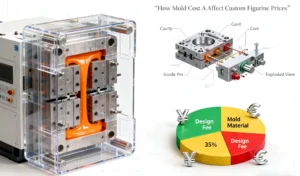Different toys require different manufacturing processes, and each technique directly impacts the texture, durability, and collectible value of the final product. For instance, PVC injection molding is well-suited for mass production, ensuring a balance between detail and cost; soft vinyl (sofubi) offers a unique tactile feel and retro charm; while resin casting focuses on intricate sculpting and provides flexibility for small-batch customization. Below are 8 production techniques you may consider.
1. Slush Molding (Soft Vinyl)
Process: Liquid PVC is poured into a heated metal mold. The excess is drained, leaving a thin film coating the inner walls, which solidifies upon cooling.
- Pros: Captures fine surface details, produces flexible and durable toys, lower mold costs. Perfect for art toys and designer figures.
- Cons: Slower production speed, inconsistent wall thickness.
- Limitations: Not ideal for high-volume mass production or structurally precise parts.
2. Injection Molding
Process: Plastic pellets (ABS, PVC, PP, etc.) are melted and injected under high pressure into a steel mold, cooled, and released.
- Pros: High precision, smooth surface finish, fast production cycles, great for large-scale manufacturing.
- Cons: High upfront tooling cost, longer lead time.
- Limitations: Best for standardized mass production, less suitable for rapid iteration or small runs.
3. Resin Casting
Process: A silicone mold is created, then epoxy or polyurethane resin is poured, degassed, and cured before demolding.
- Pros: Extremely detailed, great for small batches, allows special effects like transparency.
- Cons: Labor-intensive, less efficient than automated processes.
- Limitations: Limited scalability, lower structural strength.
4. Rotocasting (Rotational Casting)
Process: Liquid resin or vinyl is poured into a hollow mold, which rotates on multiple axes, spreading the material evenly until cured.
- Pros: Produces hollow, lightweight models, material-efficient, ideal for large figures or shells.
- Cons: Inconsistent wall thickness, less structural reliability.
- Limitations: Suited for outer shells or decorative pieces, not for load-bearing components.
5. Thermoforming / Vacuum Forming
Process: Plastic sheets are heated until pliable, then vacuum-formed over a mold and trimmed after cooling.
- Pros: Low cost, quick turnaround, suitable for packaging and transparent covers.
- Cons: Limited to thin, sheet-based shapes, cannot replicate complex 3D details.
- Limitations: Primarily used for accessories and packaging, not main toy bodies.
6. 3D Printing + Resin Casting
Process: SLA/DLP 3D printing creates a prototype, which is then molded in silicone and cast in resin for small-batch production.
- Pros: High flexibility, quick prototyping, handles complex geometries, cost-effective for small runs.
- Cons: Slow print speed, requires post-processing.
- Limitations: Not feasible for mass production, best for limited editions or prototypes.
7. CNC Machining + Resin Casting
Process: CNC milling shapes a prototype from wax or ABS, followed by silicone molding and resin casting.
- Pros: Very high precision, strong and durable prototypes, suitable for large or structural parts.
- Cons: Longer production cycle, material waste.
- Limitations: Higher cost, mainly for development or premium limited figures.
8. Overmolding
Process: A hard plastic core is created, then overmolded with soft vinyl or resin through secondary molding.
- Pros: Combines hard and soft textures, enhances realism and tactile feel, great for hybrid designs.
- Cons: Complex, time-consuming, requires advanced molds.
- Limitations: Best for partial details (hair, clothes, grips), not full-body applications.
Comparison Table
| Method | Complexity | Best Use Cases | Pros | Cons | Limitations |
|---|---|---|---|---|---|
| Slush Molding | Medium | Designer/art toys | Detailed, flexible, low mold cost | Slow, uneven wall thickness | Not for mass production |
| Injection Molding | High | Mass-market toys | Precise, efficient, smooth finish | High tooling cost, slow iteration | Less flexible |
| Resin Casting | Medium | Collectibles, small runs | Extremely detailed, special effects | Labor-heavy, slower | Limited volume, weaker strength |
| Rotocasting | Medium | Large hollow toys | Lightweight, material-saving | Thickness inconsistency | Decorative only |
| Thermoforming | Low | Packaging, covers | Low cost, fast turnaround | Thin-only shapes | Not for main figures |
| 3D Print + Casting | Medium | Prototypes, small runs | Flexible, complex designs, fast dev | Slow printing, post-processing | Not scalable |
| CNC + Casting | High | Premium prototypes | High precision, durable masters | Long cycle, material waste | High cost, niche use |
| Overmolding | High | Hybrid toys | Realistic textures, soft-hard combo | Complex, longer cycle | Only for partial parts |
Conclusion
Every method offers unique strengths and drawbacks:
- Slush and Resin Casting: Great for small-batch collectibles and detail-oriented designs.
- Injection and Overmolding: Best for large-scale production and functional toys.
- 3D Printing and CNC: Excellent for prototyping and premium limited editions.
Ultimately, the right choice depends on target market, production volume, budget, and design detail requirements.
👉 Looking to bring your toy model idea to life? Our expert team offers end-to-end solutions from design to manufacturing. Contact us today to explore the best production method for your project.




